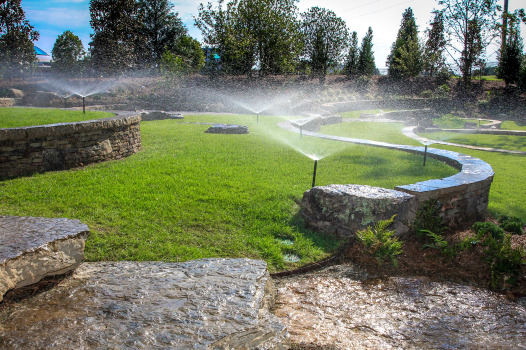Even if you have drained the water out of your irrigation system, some water remains and can freeze, expand, and crack PVC piping (rigid, white pipe). Polyethylene pipe (flexible, black pipe) is used in many freezing climates. Although polyethylene pipe is more flexible and can expand under pressure, water left inside can freeze and rupture the pipe walls. Freezing water in the backflow assembly will damage the internal components and can crack the brass body.
To minimize the risk of freeze damage, you’ll need to winterize your irrigation system. In areas where winterization is mandatory, irrigation systems are installed using one of three types of water removal: manual drain, auto drain, or blowout. If you don’t know your system type, it is best to use the blowout method.
Manual Drain Method
Use the manual drain method when manual valves are located at the end and low points of the irrigation piping. To drain these systems, simply shut off the irrigation water supply and open all the manual drain valves.
Once the water has drained out of the mainline, open the boiler drain valve or the drain cap on the stop and waste valve (whichever is used in your area) and drain all the remaining water that is between the irrigation water shut off valve and the backflow device. Open the test cocks on the backflow device. If your sprinklers have check valves, you’ll need to pull up on the sprinklers to allow the water to drain out of the bottom of the sprinkler body. Depending on the location of the drain valves, there could be some water left in the backflow, the piping, and the sprinklers. When all the water has drained out, close all the manual drain valves.
Automatic Drain Method
Use this method when automatic drain valves are located at the end and low points of the irrigation piping. These will automatically open and drain water if the pressure in the piping is less than 10 PSI. To activate these, shut off the irrigation water supply (shut off will be located in the basement and will be either a gate/globe valve, ball valve, or stop and waste valve – see drawings below) and activate a station to relieve the system pressure.
Once the water has drained out of the mainline, open the boiler drain valve or the drain cap on the stop and waste valve (whichever is used in your area) and drain the remaining water that is between the irrigation water shut off valve and the backflow device. Open the test cocks on the backflow device. If your sprinklers have check valves you’ll need to pull up on the sprinklers to allow the water to drain out the bottom of the sprinkler body. Depending on the location of the drain valves, there could be some water left in the backflow, the piping, and the sprinklers.
In some areas you might have a combination of the manual drain system on the mainline (the pipe between the irrigation water shut off valve and the valves) and auto drain system on the lateral lines (the pipe between the valves and the sprinklers).

